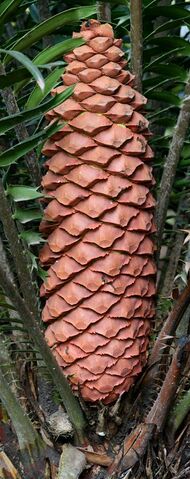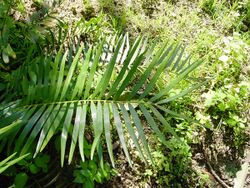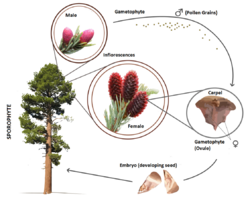Biology:Gymnosperm
| Gymnosperm | |
|---|---|

| |
| Various gymnosperms. | |
| Scientific classification | |
| Kingdom: | Plantae |
| Clade: | Tracheophytes |
| Clade: | Spermatophytes |
| Clade: | Gymnospermae |
| Living orders[1] | |
| |
The gymnosperms (/ˈdʒɪmnəspɜːrmz, -noʊ-/ JIM-nə-spurmz, -noh- ![]() pronunciation (help·info) lit. revealed seeds) are a group of seed-producing plants that includes conifers, cycads, Ginkgo, and gnetophytes, forming the clade Gymnospermae. The term gymnosperm comes from the composite word in Greek: γυμνόσπερμος (γυμνός, gymnos, 'naked' and σπέρμα, sperma, 'seed'), literally meaning 'naked seeds'. The name is based on the unenclosed condition of their seeds (called ovules in their unfertilized state). The non-encased condition of their seeds contrasts with the seeds and ovules of flowering plants (angiosperms), which are enclosed within an ovary. Gymnosperm seeds develop either on the surface of scales or leaves, which are often modified to form cones, or on their own as in yew, Torreya, Ginkgo.[2] Gymnosperm lifecycles involve alternation of generations. They have a dominant diploid sporophyte phase and a reduced haploid gametophyte phase which is dependent on the sporophytic phase. The term "gymnosperm" is often used in paleobotany to refer to (the paraphyletic group of) all non-angiosperm seed plants. In that case, to specify the modern monophyletic group of gymnosperms, the term Acrogymnospermae is sometimes used.
pronunciation (help·info) lit. revealed seeds) are a group of seed-producing plants that includes conifers, cycads, Ginkgo, and gnetophytes, forming the clade Gymnospermae. The term gymnosperm comes from the composite word in Greek: γυμνόσπερμος (γυμνός, gymnos, 'naked' and σπέρμα, sperma, 'seed'), literally meaning 'naked seeds'. The name is based on the unenclosed condition of their seeds (called ovules in their unfertilized state). The non-encased condition of their seeds contrasts with the seeds and ovules of flowering plants (angiosperms), which are enclosed within an ovary. Gymnosperm seeds develop either on the surface of scales or leaves, which are often modified to form cones, or on their own as in yew, Torreya, Ginkgo.[2] Gymnosperm lifecycles involve alternation of generations. They have a dominant diploid sporophyte phase and a reduced haploid gametophyte phase which is dependent on the sporophytic phase. The term "gymnosperm" is often used in paleobotany to refer to (the paraphyletic group of) all non-angiosperm seed plants. In that case, to specify the modern monophyletic group of gymnosperms, the term Acrogymnospermae is sometimes used.
The gymnosperms and angiosperms together comprise the spermatophytes or seed plants. The spermatophytes are subdivided into five divisions, the angiosperms and four divisions of gymnosperms: the Cycadophyta, Ginkgophyta, Gnetophyta, and Pinophyta (also known as Coniferophyta). Newer classification place the gnetophytes among the conifers.[3] Numerous extinct seed plant groups are recognised including those considered pteridosperms/seed ferns, as well other groups like the Bennettitales.[4]
By far the largest group of living gymnosperms are the conifers (pines, cypresses, and relatives), followed by cycads, gnetophytes (Gnetum, Ephedra and Welwitschia), and Ginkgo biloba (a single living species). About 65% of gymnosperms are dioecious,[5] but conifers are almost all monoecious.[6]
Some genera have mycorrhiza, fungal associations with roots (Pinus), while in some others (Cycas) small specialised roots called coralloid roots are associated with nitrogen-fixing cyanobacteria.
Diversity and origin

Over 1,000 living species of gymnosperm exist.[2] It was previously widely accepted that the gymnosperms originated in the Late Carboniferous period, replacing the lycopsid rainforests of the tropical region, but more recent phylogenetic evidence indicates that they diverged from the ancestors of angiosperms during the Early Carboniferous.[7][8] The radiation of gymnosperms during the late Carboniferous appears to have resulted from a whole genome duplication event around 319 million years ago.[9] Early characteristics of seed plants are evident in fossil progymnosperms of the late Devonian period around 383 million years ago. It has been suggested that during the mid-Mesozoic era, pollination of some extinct groups of gymnosperms was by extinct species of scorpionflies that had specialized proboscis for feeding on pollination drops. The scorpionflies likely engaged in pollination mutualisms with gymnosperms, long before the similar and independent coevolution of nectar-feeding insects on angiosperms.[10][11] Evidence has also been found that mid-Mesozoic gymnosperms were pollinated by Kalligrammatid lacewings, a now-extinct family with members which (in an example of convergent evolution) resembled the modern butterflies that arose far later.[12]
All gymnosperms are perennial woody plants,[13] Unlike in other extant gymnosperms the soft and highly parenchymatous wood in cycads is poorly lignified,[14] and their main structural support comes from an armor of sclerenchymatous leaf bases covering the stem,[15] with the exception of species with underground stems.[16] There are no herbaceous gymnosperms and compared to angiosperms they occupy fewer ecological niches, but have evolved both parasites (Parasitaxus), epiphytes (Zamia pseudoparasitica) and rheophytes (Retrophyllum minus).[17]
Conifers are by far the most abundant extant group of gymnosperms with six to eight families, with a total of 65–70 genera and 600–630 species (696 accepted names).[18] Most conifers are evergreens.[19] The leaves of many conifers are long, thin and needle-like, while other species, including most Cupressaceae and some Podocarpaceae, have flat, triangular scale-like leaves. Agathis in Araucariaceae and Nageia in Podocarpaceae have broad, flat strap-shaped leaves.
Cycads are the next most abundant group of gymnosperms, with two or three families, 11 genera, and approximately 338 species. A majority of cycads are native to tropical climates and are most abundantly found in regions near the equator. The other extant groups are the 95–100 species of Gnetales and one species of Ginkgo.[4]
Today gymnosperms are the most threatened of all plant groups.[20]
Classification
| Phylogeny of Acrogymnospermae[21][22][23][24] | |||||||||||||||||||||||||||||||||||||||||||||||||||||||||||||||||||||||||||||||||||||||||||||||||||||||||||||||||||||||||||||||||||||||||||||||||||||||||||||||||||||||||||||||||||||||||||||||||||||||||||||||||||||||||||||||||||||||||||||||||||||||||||||||||||||||||||||||||||||||||||||||||||||||||||||||||||||||||||||||||||||||||||||
|
A formal classification of the living gymnosperms is the "Acrogymnospermae", which form a monophyletic group within the spermatophytes.[25][26] The wider "Gymnospermae" group includes extinct gymnosperms and is thought to be paraphyletic. The fossil record of gymnosperms includes many distinctive taxa that do not belong to the four modern groups, including seed-bearing trees that have a somewhat fern-like vegetative morphology (the so-called "seed ferns" or pteridosperms).[27] When fossil gymnosperms such as these and the Bennettitales, glossopterids, and Caytonia are considered, it is clear that angiosperms are nested within a larger gymnospermae clade, although which group of gymnosperms is their closest relative remains unclear.
The extant gymnosperms include 12 main families and 83 genera which contain more than 1000 known species.[2][26][28]
Subclass Cycadidae
- Order Cycadales
- Family Cycadaceae: Cycas
- Family Zamiaceae: Dioon, Bowenia, Macrozamia, Lepidozamia, Encephalartos, Stangeria, Ceratozamia, Microcycas, Zamia
Subclass Ginkgoidae
- Order Ginkgoales
- Family Ginkgoaceae: Ginkgo
Subclass Gnetidae
- Order Welwitschiales
- Family Welwitschiaceae: Welwitschia
- Order Gnetales
- Order Ephedrales
- Family Ephedraceae: Ephedra
Subclass Pinidae
- Order Pinales
- Family Pinaceae: Cedrus, Pinus, Cathaya, Picea, Pseudotsuga, Larix, Pseudolarix, Tsuga, Nothotsuga, Keteleeria, Abies
- Order Araucariales
- Family Araucariaceae: Araucaria, Wollemia, Agathis
- Family Podocarpaceae: Phyllocladus, Lepidothamnus, Prumnopitys, Sundacarpus, Halocarpus, Parasitaxus, Lagarostrobos, Manoao, Saxegothaea, Microcachrys, Pherosphaera, Acmopyle, Dacrycarpus, Dacrydium, Falcatifolium, Retrophyllum, Nageia, Afrocarpus, Podocarpus
- Order Cupressales
- Family Sciadopityaceae: Sciadopitys
- Family Cupressaceae: Cunninghamia, Taiwania, Athrotaxis, Metasequoia, Sequoia, Sequoiadendron, Cryptomeria, Glyptostrobus, Taxodium, Papuacedrus, Austrocedrus, Libocedrus, Pilgerodendron, Widdringtonia, Diselma, Fitzroya, Callitris, Actinostrobus, Neocallitropsis, Thujopsis, Thuja, Fokienia, Chamaecyparis, Cupressus, Juniperus, Calocedrus, Tetraclinis, Platycladus, Microbiota
- Family Taxaceae: Austrotaxus, Pseudotaxus, Taxus, Cephalotaxus, Amentotaxus, Torreya
Extinct groupings
- Order Cordaitales
- Order Calamopityales
- Order Callistophytales
- Order Caytoniales
- Order Gigantopteridales
- Order Glossopteridales
- Order Lyginopteridales
- Order Medullosales
- Order Peltaspermales
- Order Corystospermales (also known as Umkomasiales)
- Order Czekanowskiales
- Order Bennettitales (cycadeoids)
- Order Erdtmanithecales
- Order Pentoxylales
- Order Czekanowskiales
- Order Petriellales
Life cycle
Gymnosperms, like all vascular plants, have a sporophyte-dominant life cycle, which means they spend most of their life cycle with diploid cells, while the gametophyte (gamete-bearing phase) is relatively short-lived. Like all seed plants, they are heterosporous, having two spore types, microspores (male) and megaspores (female) that are typically produced in pollen cones or ovulate cones, respectively.[29] The exception is the females in the cycad genus Cycas, which form a loose structure called megasporophylls instead of cones.[30] As with all heterosporous plants, the gametophytes develop within the spore wall. Pollen grains (microgametophytes) mature from microspores, and ultimately produce sperm cells.[29] Megagametophytes develop from megaspores and are retained within the ovule. Gymnosperms produce multiple archegonia, which produce the female gamete.
During pollination, pollen grains are physically transferred between plants from the pollen cone to the ovule. Pollen is usually moved by wind or insects. Whole grains enter each ovule through a microscopic gap in the ovule coat (integument) called the micropyle. The pollen grains mature further inside the ovule and produce sperm cells. Two main modes of fertilization are found in gymnosperms. Cycads and Ginkgo have flagellated motile sperm[31] that swim directly to the egg inside the ovule, whereas conifers and gnetophytes have sperm with no flagella that are moved along a pollen tube to the egg. After syngamy (joining of the sperm and egg cell), the zygote develops into an embryo (young sporophyte). More than one embryo is usually initiated in each gymnosperm seed. The mature seed comprises the embryo and the remains of the female gametophyte, which serves as a food supply, and the seed coat.[32]
Genetics
The first published sequenced genome for any gymnosperm was the genome of Picea abies in 2013.[33]
Uses
Gymnosperms have major economic uses. Pine, fir, spruce, and cedar are all examples of conifers that are used for lumber, paper production, and resin. Some other common uses for gymnosperms are soap, varnish, nail polish, food, gum, and perfumes.[34]
References
- ↑ "Recent advances on phylogenomics of gymnosperms and a new classification". Plant Diversity 44 (4): 340–350. 2020. doi:10.1016/j.pld.2022.05.003. ISSN 2468-2659. PMID 35967253.
- ↑ 2.0 2.1 2.2 "Gymnosperms on The Plant List". Theplantlist.org. http://www.theplantlist.org/browse/G/.
- ↑ Yang, Yong; Ferguson, David Kay; Liu, Bing; Mao, Kang-Shan; Gao, Lian-Ming; Zhang, Shou-Zhou; Wan, Tao; Rushforth, Keith et al. (2022-07-01). "Recent advances on phylogenomics of gymnosperms and a new classification" (in en). Plant Diversity 44 (4): 340–350. doi:10.1016/j.pld.2022.05.003. ISSN 2468-2659. PMID 35967253.
- ↑ 4.0 4.1 Raven, P.H. (2013). Biology of Plants. New York: W.H. Freeman and Co..
- ↑ Walas, Łukasz; Mandryk, Wojciech; Thomas, Peter A.; Tyrała-Wierucka, Żanna; Iszkuło, Grzegorz (2018-09-01). "Sexual systems in gymnosperms: A review" (in en). Basic and Applied Ecology 31: 1–9. doi:10.1016/j.baae.2018.05.009. ISSN 1439-1791. https://www.sciencedirect.com/science/article/abs/pii/S1439179117304498.
- ↑ "Sexual systems in gymnosperms: A review". Basic and Applied Ecology 31: 1–9. 2018. doi:10.1016/j.baae.2018.05.009. http://eprints.keele.ac.uk/4961/1/29052018_1-s2.0-S1439179117304498-main.pdf.
- ↑ Li, Hong-Tao; Yi, Ting-Shuang; Gao, Lian-Ming; Ma, Peng-Fei; Zhang, Ting; Yang, Jun-Bo; Gitzendanner, Matthew A.; Fritsch, Peter W. et al. (May 2019). "Origin of angiosperms and the puzzle of the Jurassic gap" (in en). Nature Plants 5 (5): 461–470. doi:10.1038/s41477-019-0421-0. PMID 31061536.
- ↑ Morris, Jennifer L.; Puttick, Mark N.; Clark, James W.; Edwards, Dianne; Kenrick, Paul; Pressel, Silvia; Wellman, Charles H.; Yang, Ziheng et al. (2018-03-06). "The timescale of early land plant evolution". Proceedings of the National Academy of Sciences of the United States of America 115 (10): E2274–E2283. doi:10.1073/pnas.1719588115. PMID 29463716. Bibcode: 2018PNAS..115E2274M.
- ↑ Jiao, Yuannian; Wickett, Norman J.; Ayyampalayam, Saravanaraj; Chanderbali, André S.; Landherr, Lena; Ralph, Paula E.; Tomsho, Lynn P.; Hu, Yi et al. (2011-04-10). "Ancestral polyploidy in seed plants and angiosperms". Nature 473 (7345): 97–100. doi:10.1038/nature09916. PMID 21478875. Bibcode: 2011Natur.473...97J.
- ↑ Ollerton, J.; Coulthard, E. (2009). "Evolution of Animal Pollination". Science 326 (5954): 808–809. doi:10.1126/science.1181154. PMID 19892970. Bibcode: 2009Sci...326..808O.
- ↑ Ren, D; Labandeira, CC; Santiago-Blay, JA; Rasnitsyn, A et al. (2009). "A Probable Pollination Mode Before Angiosperms: Eurasian, Long-Proboscid Scorpionflies". Science 326 (5954): 840–847. doi:10.1126/science.1178338. PMID 19892981. Bibcode: 2009Sci...326..840R.
- ↑ Labandeira, Conrad C.; Yang, Qiang; Santiago-Blay, Jorge A.; Hotton, Carol L.; Monteiro, Antónia; Wang, Yong-Jie; Goreva, Yulia; Shih, ChungKun et al. (2016). "The evolutionary convergence of mid-Mesozoic lacewings and Cenozoic butterflies". Proceedings of the Royal Society B: Biological Sciences 283 (1824): 20152893. doi:10.1098/rspb.2015.2893. PMID 26842570.
- ↑ Bond, W. J. (March 1989). "The tortoise and the hare: ecology of angiosperm dominance and gymnosperm persistence". Biological Journal of the Linnean Society 36 (3): 227–249. doi:10.1111/j.1095-8312.1989.tb00492.x.
- ↑ Fisher, Jack B.; Lindström, Anders; Marler, Thomas E. (2009-06-01). "Tissue Responses and Solution Movement After Stem Wounding in Six Cycas Species" (in en-US). HortScience 44 (3): 848–851. doi:10.21273/HORTSCI.44.3.848. ISSN 0018-5345. https://journals.ashs.org/hortsci/view/journals/hortsci/44/3/article-p848.xml.
- ↑ Bell, Peter R.; Bell, Peter R.; Hemsley, Alan R. (2000). Green Plants: Their Origin and Diversity. Cambridge University Press. p. 247. ISBN 978-0-521-64673-4. https://books.google.com/books?id=HYkTvGq_RccC&q=armor%2520sclerenchymatous%2520leaf%2520bases&pg=PA247.
- ↑ Cleal, Christopher J.; Thomas, Barry A. (2019). Introduction to Plant Fossils. Cambridge University Press. p. 179. ISBN 978-1-108-48344-5. https://books.google.com/books?id=KDGdDwAAQBAJ&q=%2522exclusively%2520underground%2C%2520like%2520a%2520tuber%2520%28e.g.%2520some%2520Zamia%2520species%29%2522&pg=PA179.
- ↑ Mill, R. R. (2016-06-22). "A Monographic Revision of Retrophyllum (Podocarpaceae)" (in en). Edinburgh Journal of Botany 73 (2): 171–261. doi:10.1017/S0960428616000081. ISSN 1474-0036. https://www.cambridge.org/core/journals/edinburgh-journal-of-botany/article/monographic-revision-of-retrophyllum-podocarpaceae/029F1D48E9AFB1134D527CFF639B7F2E.
- ↑ A. Farjon, ed (2006). "Conifer database". Catalogue of Life: 2008 Annual checklist. http://www.catalogueoflife.org/show_database_details.php?database_name=Conifer+Database.
- ↑ Campbell, Reece, "Phylum Coniferophyta."Biology. 7th. 2005. Print. P.595
- ↑ Gilbert, Natasha (2010-09-28). "Threats to the world's plants assessed" (in en). Nature. doi:10.1038/news.2010.499. ISSN 1476-4687. https://www.nature.com/articles/news.2010.499.
- ↑ Leslie, Andrew B.Expression error: Unrecognized word "et". (2018). "An overview of extant conifer evolution from the perspective of the fossil record". American Journal of Botany 105 (9): 1531–1544. doi:10.1002/ajb2.1143. PMID 30157290. https://doi.org/10.1002/ajb2.1143.
- ↑ Leslie, Andrew B. (2018). "ajb21143-sup-0004-AppendixS4". American Journal of Botany 105 (9): 1531–1544. doi:10.1002/ajb2.1143. PMID 30157290. https://bsapubs.onlinelibrary.wiley.com/action/downloadSupplement?doi=10.1002%2Fajb2.1143&file=ajb21143-sup-0004-AppendixS4.pdf.
- ↑ Stull, Gregory W.Expression error: Unrecognized word "et". (2021). "Gene duplications and phylogenomic conflict underlie major pulses of phenotypic evolution in gymnosperms". Nature Plants 7 (8): 1015–1025. doi:10.1038/s41477-021-00964-4. PMID 34282286. https://www.nature.com/articles/s41477-021-00964-4.
- ↑ Stull, Gregory W. (2021). main.dated.supermatrix.tree.T9.tre (Report). Figshare. doi:10.6084/m9.figshare.14547354.v1. https://figshare.com/articles/dataset/Gene_duplications_and_genomic_conflict_underlie_major_pulses_of_phenotypic_evolution_in_gymnosperms/14547354.
- ↑ Cantino 2007.
- ↑ 26.0 26.1 Christenhusz, M.J.M.; Reveal, J.L.; Farjon, A.; Gardner, M.F.; Mill, R.R.; Chase, M.W. (2011). "A new classification and linear sequence of extant gymnosperms". Phytotaxa 19: 55–70. doi:10.11646/phytotaxa.19.1.3. http://www.mapress.com/phytotaxa/content/2011/f/pt00019p070.pdf.
- ↑ Hilton, Jason; Bateman, Richard M. (January 2006). "Pteridosperms are the backbone of seed-plant phylogeny 1" (in en). The Journal of the Torrey Botanical Society 133 (1): 119–168. doi:10.3159/1095-5674(2006)133[119:PATBOS2.0.CO;2].
- ↑ Christenhusz, M. J. M.; Byng, J. W. (2016). "The number of known plants species in the world and its annual increase". Phytotaxa 261 (3): 201–217. doi:10.11646/phytotaxa.261.3.1. http://biotaxa.org/Phytotaxa/article/download/phytotaxa.261.3.1/20598.
- ↑ 29.0 29.1 Samantha, Fowler; Rebecca, Roush; James, Wise (2013). "14.3 Seed Plants: Gymnosperms". Concepts of Biology. Houston, Texas: OpenStax. https://openstax.org/books/concepts-biology/pages/14-3-seed-plants-gymnosperms. Retrieved 31 March 2023.
- ↑ Liu, Yang; Wang, Sibo; Li, Linzhou; Yang, Ting; Dong, Shanshan; Wei, Tong; Wu, Shengdan; Liu, Yongbo et al. (April 2022). "The Cycas genome and the early evolution of seed plants" (in en). Nature Plants 8 (4): 389–401. doi:10.1038/s41477-022-01129-7. ISSN 2055-0278. PMID 35437001.
- ↑ Southworth, Darlene; Cresti, Mauro (September 1997). "Comparison of flagellated and nonflagellated sperm in plants". American Journal of Botany 84 (9): 1301–1311. doi:10.2307/2446056. PMID 21708687. https://bsapubs.onlinelibrary.wiley.com/doi/pdf/10.2307/2446056. Retrieved 26 March 2022.
- ↑ Walters, Dirk R Walters Bonnie By (1996). Vascular plant taxonomy. Dubuque, Iowa: Kendall/Hunt Pub. Co.. p. 124. ISBN 978-0-7872-2108-9. https://archive.org/details/vascularplanttax00walt. "Gymnosperm seeds."
- ↑ Nystedt, BExpression error: Unrecognized word "etal". (May 2013). "The Norway spruce genome sequence and conifer genome evolution". Nature 497 (7451): 579–584. doi:10.1038/nature12211. PMID 23698360. Bibcode: 2013Natur.497..579N.
- ↑ Biswas, C.; Johri, B.M. (1997). "Economic Importance". The Gymnosperms. Springer, Berlin, Heidelberg. pp. 440–456. doi:10.1007/978-3-662-13164-0_23. ISBN 978-3-662-13166-4. https://link.springer.com/content/pdf/10.1007%2F978-3-662-13164-0.pdf.
General bibliography
- Cantino, Philip D.; Doyle, James A.; Graham, Sean W.; Judd, Walter S.; Olmstead, Richard G.; Soltis, Douglas E.; Soltis, Pamela S.; Donoghue, Michael J. (August 2007). "Towards a phylogenetic nomenclature of Tracheophyta". Taxon 56 (3): 822–846. doi:10.2307/25065864.
External links
Wikidata ☰ Q133712 entry
 |



